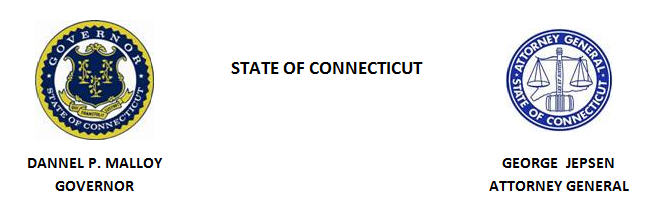
Gov. Malloy, AG Jepsen Remind Coaches, Parents to
Beware Sports-related Concussion Signs and Symptoms
During fall youth sports season, preventing head injuries is critical
With the fall school sports season upon us, Governor Dannel P. Malloy and Attorney General George Jepsen are reminding student athletes, parents and coaches that head injuries and concussions are serious and that Connecticut law requires students who suffer a blow to the head or receive a concussion diagnosis to sit out games and practices until cleared by a licensed medical professional.
“The dangers and lifelong effects of concussions and sports-related head injuries are becoming increasingly clear to doctors and educators who are researching this issue,” Governor Malloy said. “We are urging parents, coaches and students to take these types of injuries seriously – recognize the signs and symptoms consistent with a concussion and allow the time to completely heal before resuming playing.”
“A concussion is a very serious injury, and an athlete who has suffered a concussion needs time to heal,” said Attorney General Jepsen. “While proper use of helmets and protective equipment is important, it’s critical to remember that no helmet can fully prevent a concussion. Preventing head injuries by limiting contact is key. Parents, athletes and coaches should educate themselves in order to recognize the signs of injury and prevent concussions in youth sports.”
Concussion, a type of traumatic brain injury, is caused by a bump, blow or jolt to the head. Concussions can also occur from a blow to the body that causes the head and brain to move quickly back and forth.
Under Connecticut law, anyone who has a state-issued coaching permit and who coaches intramural or interscholastic athletics must be periodically trained in how to recognize and respond to head injuries and concussions. State law also requires coaches to take a student athlete out of any game or practice if the athlete shows signs of having suffered a concussion after an observed or suspected blow to the head or if the athlete is diagnosed with a concussion. Coaches must keep athletes out of games and practices until receiving written clearance from a licensed medical professional.
The Centers for Disease Control and Prevention (CDC) advise that to help minimize the risks of concussion or other serious brain injuries:
• Ensure that athletes follow the rules for safety and the rules of the sport.
• Encourage them to practice good sportsmanship at all times.
• Wear a helmet to reduce the risk of severe brain injury and skull fracture. However, helmets are not designed to prevent concussions. There is no “concussion-proof” helmet. Even with a helmet, avoiding hits to the head is important.
• Encourage them to practice good sportsmanship at all times.
• Wear a helmet to reduce the risk of severe brain injury and skull fracture. However, helmets are not designed to prevent concussions. There is no “concussion-proof” helmet. Even with a helmet, avoiding hits to the head is important.
According to the CDC, parents or coaches may observe the following signs or symptoms if an athlete has experienced head trauma:
• Appears dazed or stunned.
• Is confused about assignment or position or is unsure of the game, score or opponent.
• Moves clumsily.
• Answers questions slowly or forgets an instruction.
• Can’t recall events prior to or after the hit, bump or fall.
• Loses consciousness, even briefly.
• Shows mood, behavior or personality changes.
• Is confused about assignment or position or is unsure of the game, score or opponent.
• Moves clumsily.
• Answers questions slowly or forgets an instruction.
• Can’t recall events prior to or after the hit, bump or fall.
• Loses consciousness, even briefly.
• Shows mood, behavior or personality changes.
Student athletes may report the following symptoms following a bump, blow or jolt to the head, according to the CDC:
• Headache or “pressure” in the head;
• Nausea or vomiting;
• Balance problems or dizziness;
• Double or blurry vision;
• Sensitivity to light and noise;
• Feeling sluggish, hazy, foggy or groggy;
• Concentration or memory problems;
• Confusion; or
• Just “not feeling right” or “feeling down”
• Nausea or vomiting;
• Balance problems or dizziness;
• Double or blurry vision;
• Sensitivity to light and noise;
• Feeling sluggish, hazy, foggy or groggy;
• Concentration or memory problems;
• Confusion; or
• Just “not feeling right” or “feeling down”
For more information on student athlete concussions as well as resources for parents and coaches, visit www.cdc.gov/ConcussionInYouthSports.
###
Media Contacts:
Office of the Governor:
David Bednarz
860-524-7315 (office)
860-770-9792 (cell)
Office of the Attorney General:
Jaclyn M. Falkowski
860-808-5324 (office)
860-655-3903 (cell)
Consumer Inquiries:
860-808-5318
Facebook: Attorney General George Jepsen
Twitter: @AGJepsen


